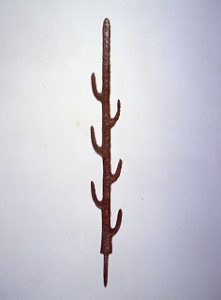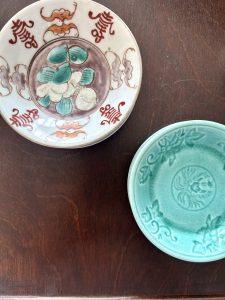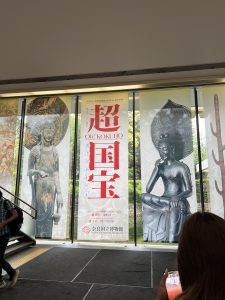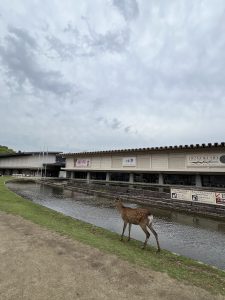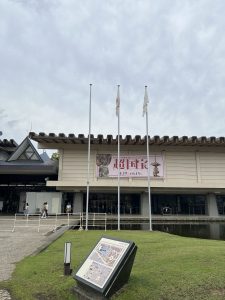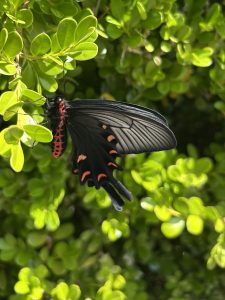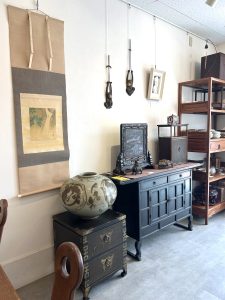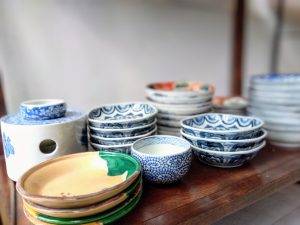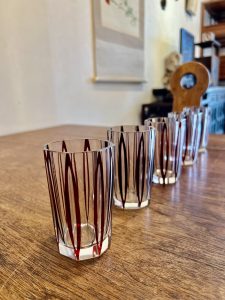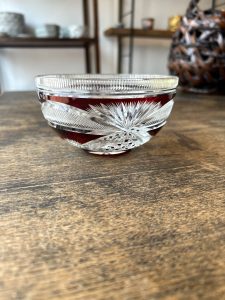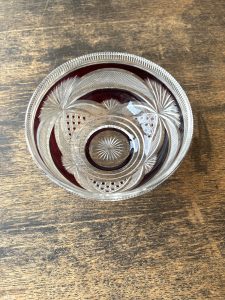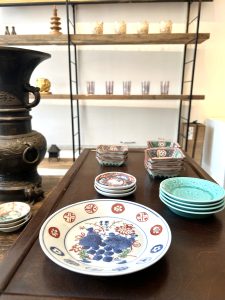手作りの梅酒、梅干しは…(愛知県名古屋市千種区姫池通 骨董買取 古美術風光舎)
2025.05.23
スーパーなどの店頭に青梅が並んでいるのを見て、「あ、今年もそんな季節か」と思いましたが、家庭での「梅しごと」を始めたい方にとっては、いつ漬けるかタイミングを見計らっているところでしょうか。
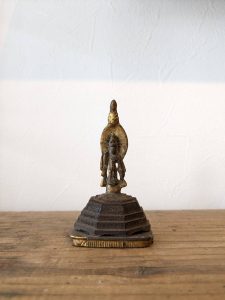
先日、梅雨前に少し片づけたいということで、実家の手伝いをしておりましたら、床下収納から忘れられていた、かなり古い梅酒と梅干しがいくつか出てきました。おそらく10年以上前のもの(下手したらそれ以上のものも出てきそうです)と思しきもの。まず思ったことは、「これまだ大丈夫なの?」でした。
皆さまも手作りがご趣味で、毎年作られている方も多くいらっしゃるかもしれませんね。母も梅干し・梅酒を手作りするのが好きで、毎年作っていました。ですが母はお酒をほとんど飲みません。皆さまも疑問に思ったことはありませんか?「飲みもしないのになんで毎年漬けるのか?」。
今思えば、それは1年に1回の恒例行事となっていましたし、梅の効能についても絶大な信頼があったのかもしれませんが、それはもうやらねばならぬと言ったような義務感みたいなものを感じなくもなかったわけですが、手間のかかる手作りの(しかも体にいいとされる)ものを娘達に送ってあげたいという優しさもあったのでしょうし、もはや生きがいのようになっていたのかもしれません。
ありがたいことだったのですが、大量に送ってくるので、前年のものが終わらないうちに今年のものが来てしまうようになり、「まだ残っているから今年は要らない」とでも言おうものなら「人の好意を無駄にして!」と怒られることもありました。
そんな感じでしたので、毎年漬けていた梅酒や梅干しがたくさん残っていたのです。
おそるおそる、味、においを確認したところ傷んではいない様です。しかし大きなビンにぎっしり入っていて、どうしたものやら。梅干しも食べすぎれば塩分取り過ぎになりそうですし、梅煮に使うと言ってもやはり毎日というわけにはいきません。しかも私もお酒はほとんど飲まないうえ、甘いお酒はあまり飲みません。
皆さま、こういった時、どう消費されていますか?もしくは捨ててしまいますか?
私も心を鬼にして捨てようかと思いましたが、梅干しも梅酒も、1つずつ布巾で拭いて、竹串でヘタを取って穴を開けて、と手間がかかる事を知っているので、それを簡単に捨てるなどというのは気が引けます。
こういう場合、何年、何十年かかっても食べきるべきでしょうか…。
調べてみると、「梅酒 古い 捨て方 使い道」などの検索ワードがまあまあヒットしまして。わたしのように処分の仕方に困っている方けっこういるんですね。どうやら、保存状態が良ければ、年数がたつほど梅酒はまろやかになるそうで、全然飲めます!と20年前のものを飲まれたいうご意見も。あえて何年も寝かせている梅酒・梅干しをお持ちの方もいらっしゃるようで…。梅干は10年ものが一粒数百円以上になったものもあるとか?
はてさてどうしたものか…。人に差し上げる時は本当に喜んでもらってるのか、押し付けになっていないか…。私も気をつけたいと思います。
ではでは、また。(スタッフT)
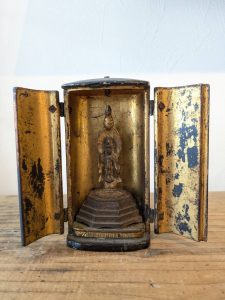
When I saw green plums on the shelves of supermarkets, I thought, “Oh, it’s that time of year again,” but for those who want to start “ume-shigoto” at home, they are probably looking for the right time when to start pickling plums.
The other day, I was helping out at my parents’ house to clean up a little before the rainy season, and I found some old plum wine and pickled plums that had been forgotten in the underfloor storage. They were probably more than 10 years old (or more if I am not mistaken). My first thought was, “Are these still safe?” I thought, “Is this still good?
Many of you may have a hobby of handmade products and make them every year. My mother also liked to make pickled plums and plum wine by hand, and she did so every year. However, she rarely drinks alcohol. Have you ever wondered why she doesn’t drink? “If she doesn’t drink, why does she make pickled plums every year?” I think now, it is because she makes it every year.
Looking back, it had become an annual event, and she may have had great faith in the efficacy of ume, but I could not help but feel a sense of obligation to do it, as if I had to. I guess I also had the kindness of wanting to send my daughters something handmade and time-consuming (and also good for their health), and perhaps it had become a kind of purpose in my life.
I was very grateful, but they sent so many that this year’s gifts came before the previous year’s ones were finished. If I tried to say, “I don’t want it this year because it’s still left,” I would be scolded.
So we had a lot of pickled plums and umeboshi left over from our annual pickling.
I checked the taste and smell with trepidation, and found that they were undamaged. However, they were packed in a large jar, and I wondered what to do with them. If I eat too many dried plums, I might take in too much salt, and even if I use them to stew plums, I can’t use them every day. Moreover, I rarely drink alcohol, and I don’t drink sweet drinks very much either.
What do you do with them? Or do you throw them away?
I thought about throwing them away, but I know that it takes a lot of time and effort to wipe up the dried plums and plum wine one by one with a cloth, remove the stems with a bamboo skewer, and poke holes in them, so I am reluctant to simply throw them away.
In such a case, should I eat them up even if it takes me years or decades to do so?
When I did some research, I found that search terms such as “how to throw away old plum wine” were quite common. It seems that there are many people like me who are having trouble disposing of old ume-shu. Apparently, if it is well preserved, the older it gets, the mellower the plum wine becomes, and it is still drinkable! Some people even said they would like to drink the ones that are 20 years old. Some people seem to have plum wine and umeboshi that have been stored for years on purpose. Some of the 10-year-old pickled plums are now priced at more than several hundred yen each…?
Well, what should we do with them…? When I give them to people, I wonder if they are really pleased with them or if I am just pushing them…. I will be careful too.
See you soon. (Staff T)
*****************
ご実家の整理やお片付けなどをされている方のご相談などが多くございます。
お片付けなどくれぐれもご無理のないようになさってくださいませ。
風光舎では古美術品や骨董品の他にも絵画や宝石、趣味のお品など様々なジャンルのものを買受しております。
お片付けをされていて、こういうものでもいいのかしらと迷われているものでも、どうぞお気軽にご相談下さいませ。
また風光舎は、出張買取も強化しております。ご近所はもちろん、愛知県内、岐阜県、三重県その他の県へも出張いたします。
まずは、お電話お待ちしております。
なお、毎月21日の持込鑑定会では無料鑑定・買取・持込など、ご予約なしで承っております。
ご近所の皆さま、ご遠方のみなさまも、お気軽にお越しくださいませ。
愛知県名古屋市千種区姫池通
骨董 買取【古美術 風光舎 名古屋店】
TEL052(734)8444
10:00-18:00 OPEN
#出張買取#骨董#古美術#骨董品#絵画#版画#茶道具#刀剣#彫刻

